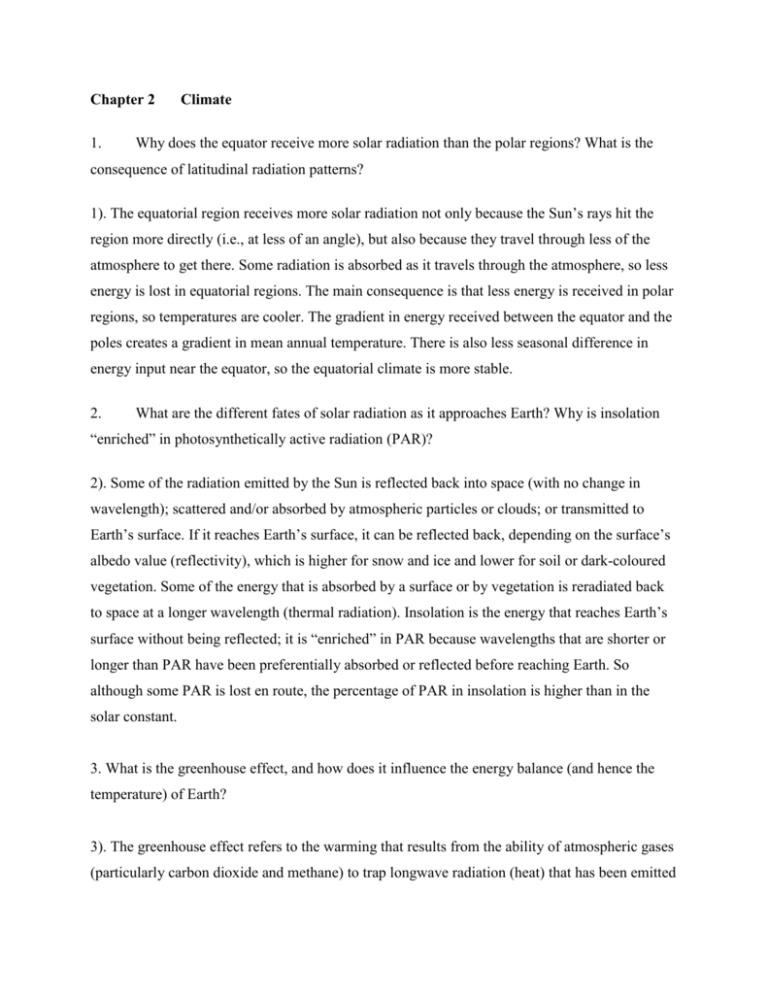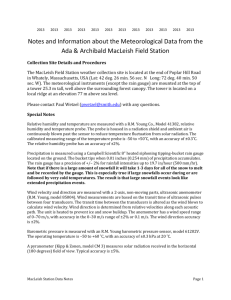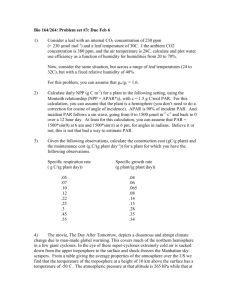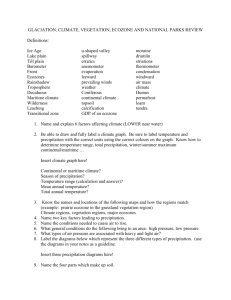Chapter 2 Climate 1. Why does the equator receive more solar
advertisement

Chapter 2 1. Climate Why does the equator receive more solar radiation than the polar regions? What is the consequence of latitudinal radiation patterns? 1). The equatorial region receives more solar radiation not only because the Sun’s rays hit the region more directly (i.e., at less of an angle), but also because they travel through less of the atmosphere to get there. Some radiation is absorbed as it travels through the atmosphere, so less energy is lost in equatorial regions. The main consequence is that less energy is received in polar regions, so temperatures are cooler. The gradient in energy received between the equator and the poles creates a gradient in mean annual temperature. There is also less seasonal difference in energy input near the equator, so the equatorial climate is more stable. 2. What are the different fates of solar radiation as it approaches Earth? Why is insolation “enriched” in photosynthetically active radiation (PAR)? 2). Some of the radiation emitted by the Sun is reflected back into space (with no change in wavelength); scattered and/or absorbed by atmospheric particles or clouds; or transmitted to Earth’s surface. If it reaches Earth’s surface, it can be reflected back, depending on the surface’s albedo value (reflectivity), which is higher for snow and ice and lower for soil or dark-coloured vegetation. Some of the energy that is absorbed by a surface or by vegetation is reradiated back to space at a longer wavelength (thermal radiation). Insolation is the energy that reaches Earth’s surface without being reflected; it is “enriched” in PAR because wavelengths that are shorter or longer than PAR have been preferentially absorbed or reflected before reaching Earth. So although some PAR is lost en route, the percentage of PAR in insolation is higher than in the solar constant. 3. What is the greenhouse effect, and how does it influence the energy balance (and hence the temperature) of Earth? 3). The greenhouse effect refers to the warming that results from the ability of atmospheric gases (particularly carbon dioxide and methane) to trap longwave radiation (heat) that has been emitted from Earth and the atmosphere. This absorbed energy is then re-radiated back to Earth. It affects Earth’s energy budget by reducing the amount of heat that escapes to outer space, thereby raising global temperatures. 4. The 23.5° tilt of Earth gives rise to the seasons (review Figure 2.6). How would the pattern of seasons differ if the tilt were 90°? How would this affect the diurnal (night/day) cycle? 4). If the tilt of Earth were 90o rather than 23.5o, the seasonal and daily patterns of light would be more extreme, especially at higher latitudes. At the summer solstice, the Sun would be directly overhead at the North Pole, which would have a more prolonged period of extreme heat. In contrast, in winter the darkness would be complete and the Northern Hemisphere would experience a much longer, colder, and darker winter. The reverse would be true in the Southern Hemisphere. These extremes would make Earth far less habitable. Meanwhile, when the Sun would be directly overhead the North Pole, the equatorial region would be far cooler than normal and have shorter days. As a result of these more pronounced global temperature differences, storm activity would increase. 5. At noon at the same location, the air temperature was 5°C on January 20 and 25°C on July 20. The relative humidity on both days was 75%. On which day was there more water vapour in the air, and why? 5). There is far more water in the air on July 20 than January 20. Although the relative humidity of the air is the same, warmer air holds more water than cooler air. Because relative humidity is a measure of the water content of air in relation to the maximum amount of water it can hold at a given temperature, the absolute amount of water is much higher in warmer than cooler air of the same relative humidity. 6. How and why might the relative humidity of an air parcel change as it moves up a mountain? What are the consequences of these changes for precipitation? 6). As air moves up a mountain, it cools. As it cools, its saturation vapour pressure lowers below its dew point, causing precipitation to form. This effect explains the high precipitation on the windward side of a mountain. 7. What is the intertropical convergence zone (ITCZ), and how does it explain seasonal precipitation patterns in the tropics? 7). The intertropical convergence zone is a region of high precipitation in the tropics that arises from the coming together of the northeast and southeast trade winds. As these air masses converge, they pile up and warm humid air rises. As it rises, it cools to the point that it exceeds its saturation vapour pressure, causing the high precipitation of the tropics. 8. Regina is at a very similar latitude (50° N) as is London, England (51° N). Why is Regina’s climate so much (a) colder and (b) drier? 8). Although Regina and London are at similar latitudes, and hence experience similar seasonal radiation patterns, their contrasting geographic locations greatly affect their climate. London’s coastal location greatly moderates its temperature pattern. In summer, its proximity to the Atlantic makes it much cooler than Regina, which is located in the middle of a large continental landmass, while in winter its climate is much milder, also as a result of its proximity to the oceans. London receives far more precipitation (particularly in winter) as a result of moistureladen air moving on land and forming precipitation as it cools. Precipitation arising in this way is much less likely in a continental location such as central Saskatchewan. 9. How does snowfall (amount and timing) affect an ecosystem, even if vegetation is dormant when it falls? 9). Snowfall affects an ecosystem and its inhabitants in many ways, direct and indirect. It can directly affect dormant vegetation if it is in such sufficiently large amounts or accompanied by sufficiently heavy winds that it causes damage to limbs. However, its indirect effects are often much greater. Snow has an insulating effect, protecting belowground plant parts and many animals from cold and wind. This role is especially important with early-winter snowfall because it limits the depth of frost penetration. Moisture resulting from the spring snowmelt is vital for seed germination and resumption of growth by perennial plants. Large late spring snowfalls increase the likelihood and severity of spring floods. Snow depth also affects animal movements. 10. What feature of global atmospheric circulation causes the deserts of the mid-latitudes? 10). The ITCZ causes the dry belts in the subtropics in both the northern and southern hemispheres. After converging and dropping moisture over the tropics, the cooled, dry air masses descend, causing the desert zones in the subtropics of each hemisphere. 11. The Sifton Bog near London, Ontario, is dominated by Sphagnum mosses and black spruce (Picea mariana), which typically grow in colder sites farther north. What does the spruce presence suggest about this site? What non-climatic factors might be involved? 11). The presence of vegetation in atypical regions can reflect various factors. First, the prevailing local microclimate may differ from that of the surrounding region, for reasons relating to local topography. Given that this situation involves a bog, it is likely that non-climatic features of the microhabitat are involved. Drainage is likely poor, allowing the build-up of peat mosses and the type of water-logged, organic substrate in which black spruce can thrive but which inhibits other tree species. Peat buildup in turn has an insulating effect, keeping the site cooler than other sites nearby. Third, there may be factors at work relating to site history. This site could be a relict of past vegetation that dominated in the area when the climate was colder. Although the entire region was glaciated in the last ice age, its particular combination of microsite characteristics has caused this particular locality to retain the boreal vegetation that colonized after the ice sheets retreated.








